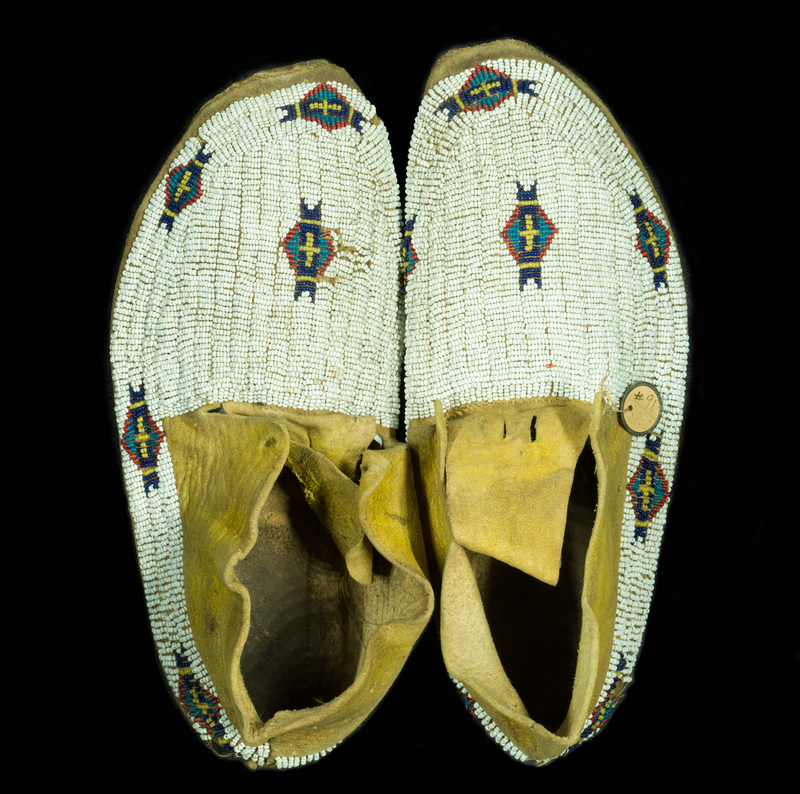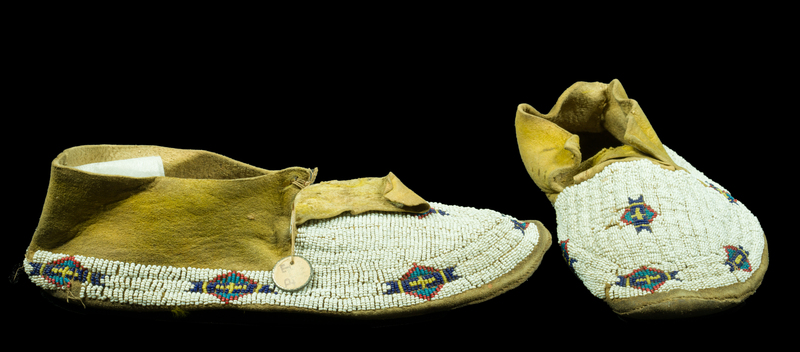Moccasins
Item
-
Title
-
Moccasins
-
Creator
-
Tsitsistas/Suhtai (Cheyenne)
-
Date
-
19thC (Late)
-
Description
-
Beaded leather Tsitsistas (Cheyenne) moccasins with geometric designs against a white background. Geometric designs are in colors that vibrantly contrast the white beading. Navy, teal, pink, and yellow beading forms rectangular and triangular forms which revolve around the outside bottom of the moccasin and also appear in the center. The leather collar of the moccasin is cut only at the tongue of the structure and slightly worn. Attached to the moccasin is a circular tag which reads on one side “#91” and “PT” on the opposite side. The moccasins are in good condition, although it appears worn and missing some beading at the edges, it is very much intact.
The moccasins are included in the ephemera of the Howard Chandler Christy Papers, which was donated to Lafayette College after his death. The artist collected a variety of objects throughout his lifetime that served as props for his models he used for his paintings. He often dressed white models in Native American artifacts and garments for his paintings such as, "Hiawatha’s Wooing", "Pocahontas" and "The Signing of the Treaty of Greene Ville." Although his work was praised for historical accuracy and his attention to detail in rendering the figures of Native Americans, his work was grossly inaccurate. He painted various individuals from distinct tribes in the same attire, which misrepresents the cultural validity of the people he is illustrating, as they would have a diverse array of traditions and clothing.
In the late 1800s, the United States actively created laws that displaced Native Americans from their land as well as legalized their dispossession. Not only were legal processes used to eradicate their land and culture, but the colonization process is most accurately exemplified by violent attacks such as the Sand Creek Massacre of 1864. The decimation of land and lives as well as laws were fueled by the idea of Manifest Destiny and expanding US interests westward which was a white supremacists ideology that sought to civilize and eradicate Native cultures. Concurrently, anthropology was becoming a professionalized field and had immense threads of these racist practices based in eugenics. Anthropologists such as Franz Boas began to study indigenous cultures using ideas based in culture and social environment to explain differences amongst groups of people, specifically in the ability to become “civilized”. The viewpoint of anthropologists was essentially ownership over the Native Americans they saw as subjects in their attempts to understand non-European culture. Study and dispossession of land are intertwined with one another and produced a system settler colonialism, where Native land was stolen for the sake of white Americans. The colonial institution at work here sought to exploit indigenous people for their labor and land but also to destroy their heritage. As anthropology increased its interest in non-European cultures as a means of understanding "savagery", anthropologists sought to salvage Native American cultural items and art because it was perceived as a dying culture. They were unable to reconcile the fact that the United States was actively causing the erasure of their culture and used it as an opportunity to steal and use their objects for academia and to strengthen the institution of the museum. The inability to acknowledge the sovereignty of Native Americans led to the destruction of their society while simultaneously seeking to loot and study their objects.
-
Rights
-
In Copyright
-
Source
-
Lafayette College, Special Collections and College Archives
-
Bibliographic Citation
-
Unknown artist, Native American Indian moccasins, n.d, leather and glass beads. Special Collections and College Archives, Lafayette College, Easton, PA.




















